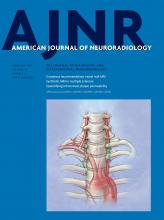Research ArticleFunctional
Reduction of Motion Artifacts and Noise Using Independent Component Analysis in Task-Based Functional MRI for Preoperative Planning in Patients with Brain Tumor
E.H. Middlebrooks, C.J. Frost, I.S. Tuna, I.M. Schmalfuss, M. Rahman and A. Old Crow
American Journal of Neuroradiology February 2017, 38 (2) 336-342; DOI: https://doi.org/10.3174/ajnr.A4996
E.H. Middlebrooks
aFrom the Department of Radiology (E.H.M.), University of Alabama at Birmingham, Birmingham, Alabama
C.J. Frost
bDepartment of Biology (C.J.F.), University of Louisville, Louisville, Kentucky
cMedical Imaging Consultants (C.J.F.), Gainesville, Florida
I.S. Tuna
dDepartments of Radiology (I.S.T., I.M.S., A.O.C.)
I.M. Schmalfuss
dDepartments of Radiology (I.S.T., I.M.S., A.O.C.)
fNorth Florida/South Georgia Veterans Administration (I.M.S.), Gainesville, Florida.
M. Rahman
eNeurosurgery (M.R.), College of Medicine, University of Florida, Gainesville, Florida
A. Old Crow
dDepartments of Radiology (I.S.T., I.M.S., A.O.C.)

References
- 1.↵
- Pillai JJ
- 2.↵
- Krings T,
- Reinges MH,
- Erberich S, et al
- 3.↵
- Ogawa S,
- Lee TM,
- Kay AR, et al
- 4.↵
- Ogawa S,
- Menon RS,
- Tank DW, et al
- 5.↵
- 6.↵
- Johnstone T,
- Ores Walsh KS,
- Greischar LL, et al
- 7.↵
- Biswal B,
- DeYoe EA,
- Hyde JS
- 8.↵
- Field AS,
- Yen YF,
- Burdette JH, et al
- 9.↵
- Krüger G,
- Glover GH
- 10.↵
- 11.↵
- Friston KJ,
- Williams S,
- Howard R, et al
- 12.↵
- Power JD,
- Barnes KA,
- Snyder AZ, et al
- 13.↵
- 14.↵
- Glover GH,
- Li TQ,
- Ress D
- 15.↵
- 16.↵
- 17.↵
- 18.↵
- 19.↵
- McKeown MJ,
- Makeig S,
- Brown GG, et al
- 20.↵
- Biswal BB,
- Ulmer JL
- 21.↵
- Quigley MA,
- Haughton VM,
- Carew J, et al
- 22.↵
- Thomas CG,
- Harshman RA,
- Menon RS
- 23.↵
- Smith SM,
- Jenkinson M,
- Woolrich MW, et al
- 24.↵
- Jenkinson M,
- Bannister P,
- Brady M, et al
- 25.↵
- 26.↵
- Kelly RE Jr.,
- Alexopoulos GS,
- Wang Z, et al
- 27.↵
- McKeown MJ,
- Hansen LK,
- Sejnowsk TJ
- 28.↵
- Kochiyama T,
- Morita T,
- Okada T, et al
- 29.↵
- Power JD,
- Fair DA,
- Schlaggar BL, et al
- 30.↵
- Desmond JE,
- Atlas SW
- 31.↵
- Krüger G,
- Kastrup A,
- Glover GH
- 32.↵
- Lund TE,
- Madsen KH,
- Sidaros K, et al
- 33.↵
- 34.↵
- Ward HA,
- Riederer SJ,
- Grimm RC, et al
- 35.↵
- 36.↵
- 37.↵
- Stone JV
- 38.↵
- 39.↵
- 40.↵
- Salimi-Khorshidi G,
- Douaud G,
- Beckmann CF, et al
- 41.↵
- Tohka J,
- Foerde K,
- Aron AR, et al
- 42.↵
- De Martino F,
- Gentile F,
- Esposito F, et al
- 43.↵
- 44.↵
- Moritz CH,
- Haughton VM,
- Cordes D, et al
- 45.↵
- Caulo M,
- Esposito R,
- Mantini D, et al
- 46.↵
- McKeown MJ
In this issue
American Journal of Neuroradiology
Vol. 38, Issue 2
1 Feb 2017
Advertisement
E.H. Middlebrooks, C.J. Frost, I.S. Tuna, I.M. Schmalfuss, M. Rahman, A. Old Crow
Reduction of Motion Artifacts and Noise Using Independent Component Analysis in Task-Based Functional MRI for Preoperative Planning in Patients with Brain Tumor
American Journal of Neuroradiology Feb 2017, 38 (2) 336-342; DOI: 10.3174/ajnr.A4996
0 Responses
Reduction of Motion Artifacts and Noise Using Independent Component Analysis in Task-Based Functional MRI for Preoperative Planning in Patients with Brain Tumor
E.H. Middlebrooks, C.J. Frost, I.S. Tuna, I.M. Schmalfuss, M. Rahman, A. Old Crow
American Journal of Neuroradiology Feb 2017, 38 (2) 336-342; DOI: 10.3174/ajnr.A4996
Jump to section
Related Articles
Cited By...
- Recommended Resting-State fMRI Acquisition and Preprocessing Steps for Preoperative Mapping of Language and Motor and Visual Areas in Adult and Pediatric Patients with Brain Tumors and Epilepsy
- Identifying brain areas for tactile perception through natural touch with MR-compatible tactile stimulus delivery system
This article has not yet been cited by articles in journals that are participating in Crossref Cited-by Linking.
More in this TOC Section
Similar Articles
Advertisement











